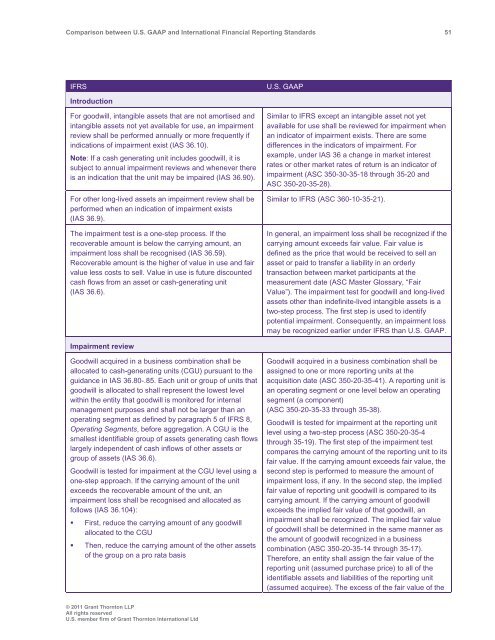Comparison between U.S. GAAP and International ... - Grant Thornton
Comparison between U.S. GAAP and International ... - Grant Thornton
Comparison between U.S. GAAP and International ... - Grant Thornton
You also want an ePaper? Increase the reach of your titles
YUMPU automatically turns print PDFs into web optimized ePapers that Google loves.
<strong>Comparison</strong> <strong>between</strong> U.S. <strong>GAAP</strong> <strong>and</strong> <strong>International</strong> Financial Reporting St<strong>and</strong>ards 51<br />
IFRS<br />
U.S. <strong>GAAP</strong><br />
Introduction<br />
For goodwill, intangible assets that are not amortised <strong>and</strong><br />
intangible assets not yet available for use, an impairment<br />
review shall be performed annually or more frequently if<br />
indications of impairment exist (IAS 36.10).<br />
Note: If a cash generating unit includes goodwill, it is<br />
subject to annual impairment reviews <strong>and</strong> whenever there<br />
is an indication that the unit may be impaired (IAS 36.90).<br />
For other long-lived assets an impairment review shall be<br />
performed when an indication of impairment exists<br />
(IAS 36.9).<br />
The impairment test is a one-step process. If the<br />
recoverable amount is below the carrying amount, an<br />
impairment loss shall be recognised (IAS 36.59).<br />
Recoverable amount is the higher of value in use <strong>and</strong> fair<br />
value less costs to sell. Value in use is future discounted<br />
cash flows from an asset or cash-generating unit<br />
(IAS 36.6).<br />
Similar to IFRS except an intangible asset not yet<br />
available for use shall be reviewed for impairment when<br />
an indicator of impairment exists. There are some<br />
differences in the indicators of impairment. For<br />
example, under IAS 36 a change in market interest<br />
rates or other market rates of return is an indicator of<br />
impairment (ASC 350-30-35-18 through 35-20 <strong>and</strong><br />
ASC 350-20-35-28).<br />
Similar to IFRS (ASC 360-10-35-21).<br />
In general, an impairment loss shall be recognized if the<br />
carrying amount exceeds fair value. Fair value is<br />
defined as the price that would be received to sell an<br />
asset or paid to transfer a liability in an orderly<br />
transaction <strong>between</strong> market participants at the<br />
measurement date (ASC Master Glossary, “Fair<br />
Value”). The impairment test for goodwill <strong>and</strong> long-lived<br />
assets other than indefinite-lived intangible assets is a<br />
two-step process. The first step is used to identify<br />
potential impairment. Consequently, an impairment loss<br />
may be recognized earlier under IFRS than U.S. <strong>GAAP</strong>.<br />
Impairment review<br />
Goodwill acquired in a business combination shall be<br />
allocated to cash-generating units (CGU) pursuant to the<br />
guidance in IAS 36.80-.85. Each unit or group of units that<br />
goodwill is allocated to shall represent the lowest level<br />
within the entity that goodwill is monitored for internal<br />
management purposes <strong>and</strong> shall not be larger than an<br />
operating segment as defined by paragraph 5 of IFRS 8,<br />
Operating Segments, before aggregation. A CGU is the<br />
smallest identifiable group of assets generating cash flows<br />
largely independent of cash inflows of other assets or<br />
group of assets (IAS 36.6).<br />
Goodwill is tested for impairment at the CGU level using a<br />
one-step approach. If the carrying amount of the unit<br />
exceeds the recoverable amount of the unit, an<br />
impairment loss shall be recognised <strong>and</strong> allocated as<br />
follows (IAS 36.104):<br />
• First, reduce the carrying amount of any goodwill<br />
allocated to the CGU<br />
• Then, reduce the carrying amount of the other assets<br />
of the group on a pro rata basis<br />
Goodwill acquired in a business combination shall be<br />
assigned to one or more reporting units at the<br />
acquisition date (ASC 350-20-35-41). A reporting unit is<br />
an operating segment or one level below an operating<br />
segment (a component)<br />
(ASC 350-20-35-33 through 35-38).<br />
Goodwill is tested for impairment at the reporting unit<br />
level using a two-step process (ASC 350-20-35-4<br />
through 35-19). The first step of the impairment test<br />
compares the carrying amount of the reporting unit to its<br />
fair value. If the carrying amount exceeds fair value, the<br />
second step is performed to measure the amount of<br />
impairment loss, if any. In the second step, the implied<br />
fair value of reporting unit goodwill is compared to its<br />
carrying amount. If the carrying amount of goodwill<br />
exceeds the implied fair value of that goodwill, an<br />
impairment shall be recognized. The implied fair value<br />
of goodwill shall be determined in the same manner as<br />
the amount of goodwill recognized in a business<br />
combination (ASC 350-20-35-14 through 35-17).<br />
Therefore, an entity shall assign the fair value of the<br />
reporting unit (assumed purchase price) to all of the<br />
identifiable assets <strong>and</strong> liabilities of the reporting unit<br />
(assumed acquiree). The excess of the fair value of the<br />
© 2011 <strong>Grant</strong> <strong>Thornton</strong> LLP<br />
All rights reserved<br />
U.S. member firm of <strong>Grant</strong> <strong>Thornton</strong> <strong>International</strong> Ltd
















